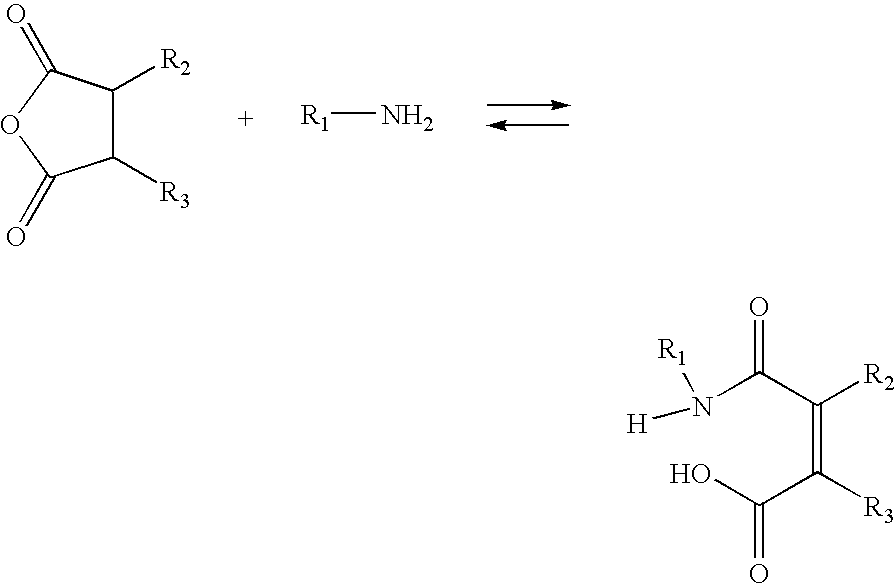Compositions and methods for drug delivery using pH sensitive molecules
a ph-sensitive, polyampholyte technology, applied in the direction of biochemistry apparatus and processes, organic chemistry, gene material ingredients, etc., can solve the problems of inactivating the specific target mrna, not being able to effectively infect all cell types, and being quite toxic to anticancer drugs, so as to enhance the delivery of a polyion to a cell
- Summary
- Abstract
- Description
- Claims
- Application Information
AI Technical Summary
Problems solved by technology
Method used
Image
Examples
example 1
Synthesis of Compounds Utilized in the Formation of Polyampholytes.
[0199]A) Synthesis of 2-propionic-3-methylmaleic anhydride (carboxydimethylmaleic anhydride or C-DM). To a suspension of sodium hydride (0.58 g, 25 mmol) in 50 mL anhydrous tetrahydrofuran was added triethyl-2-phosphonopropionate (7.1 g, 30 mmol). After bubbling of hydrogen gas stopped, dimethyl-2-oxoglutarate (3.5 g, 20 mmol) in 10 mL anhydrous tetrahydrofuran was added and stirred for 30 minutes. Water, 10 mL, was then added and the tetrahydrofuran was removed by rotary evaporation. The resulting solid and water mixture was extracted with 3×50 mL ethyl ether. The ether extractions were combined, dried with magnesium sulfate, and concentrated to a light yellow oil. The oil was purified by silica gel chromatography elution with 2:1 ether:hexane to yield 4 gm (82% yield) of pure triester. The 2-propionic-3-methylmaleic anhydride then formed by dissolving of this triester into 50 mL of a 50 / 50 mixture of water and etha...
example 2
Synthesis of Polycations
[0210]A) Synthesis of L-cystine-1,4-bis(3-aminopropyl)piperazine copolymer. To a solution of N,N′-Bis(t-BOC)-L-cystine (85 mg, 0.15 mmol) in ethyl acetate (20 mL) was added N,N′-dicyclohexylcarbodiimide (108 mg, 0.5 mmol) and N-hydroxysuccinimide (60 mg, 0.5 mmol). After 2 hr, the solution was filtered through a cotton plug and 1,4-bis(3-aminopropyl)piperazine (54 μL, 0.25 mmol) was added. The reaction was allowed to stir at room temperature for 16 h. The ethyl acetate was then removed by rotary evaporation and the resulting solid was dissolved in trifluoroacetic acid (9.5 mL), water (0.5 mL) and triisopropylsilane (0.5 mL). After 2 h, the trifluoroacetic acid was removed by rotary evaporation and the aqueous solution was dialyzed in a 15,000 MW cutoff tubing against water (2×2 l) for 24 h. The solution was then removed from dialysis tubing, filtered through 5 μM nylon syringe filter and then dried by lyophilization to yield 30 mg of polymer.
[0211]B) Synthesi...
example 3
Synthesis of Polyanions
[0270]A) Synthesis of 2,3-dimethylmaleamic poly-L-lysine. Poly-L-lysine (10 mg 34,000 MW Sigma Chemical) was dissolved in 1 mL of aqueous potassium carbonate (100 mM). To this solution was added 2,3-dimethylmaleic anhydride (100 mg, 1 mmol) and the solution was allowed to react for 2 hr. The solution was then dissolved in 5 mL of aqueous potassium carbonate (100 mM) and dialyzed against 3×2 L water that was at pH8 with addition of potassium carbonate. The solution was then concentrated by lyophilization to 10 mg / mL of 2,3-dimethylmaleamic poly-L-lysine.
[0271]B) General procedure for the reaction of mel-PAA, KL3-PAA, mel-PLL, and KL3-PLL with dimethylmaleic anhydride and 2-propionic-3-methylmaleic anhydride. Peptide-polycation conjugates (10 mg / mL) in water were reacted with a ten-fold weight excess of dimethylmaleic anhydride and a ten-fold weight excess of potassium carbonate. Analysis of the amine content after 30 by addition of peptide solution to 0.4 mM tr...
PUM
| Property | Measurement | Unit |
|---|---|---|
| size | aaaaa | aaaaa |
| pH | aaaaa | aaaaa |
| diameter | aaaaa | aaaaa |
Abstract
Description
Claims
Application Information
 Login to View More
Login to View More - R&D
- Intellectual Property
- Life Sciences
- Materials
- Tech Scout
- Unparalleled Data Quality
- Higher Quality Content
- 60% Fewer Hallucinations
Browse by: Latest US Patents, China's latest patents, Technical Efficacy Thesaurus, Application Domain, Technology Topic, Popular Technical Reports.
© 2025 PatSnap. All rights reserved.Legal|Privacy policy|Modern Slavery Act Transparency Statement|Sitemap|About US| Contact US: help@patsnap.com

